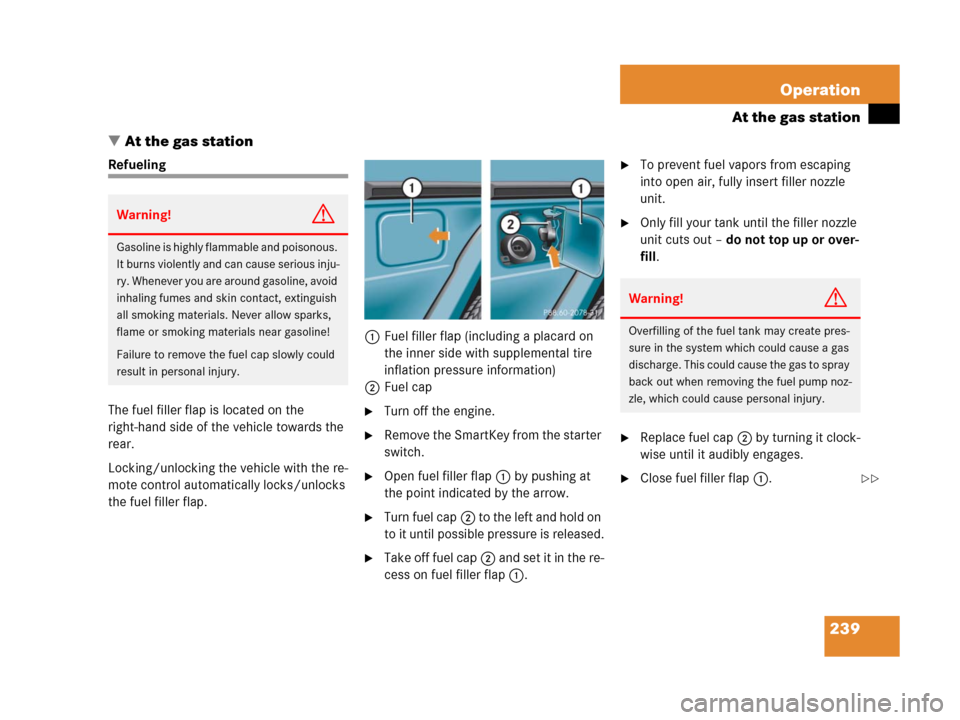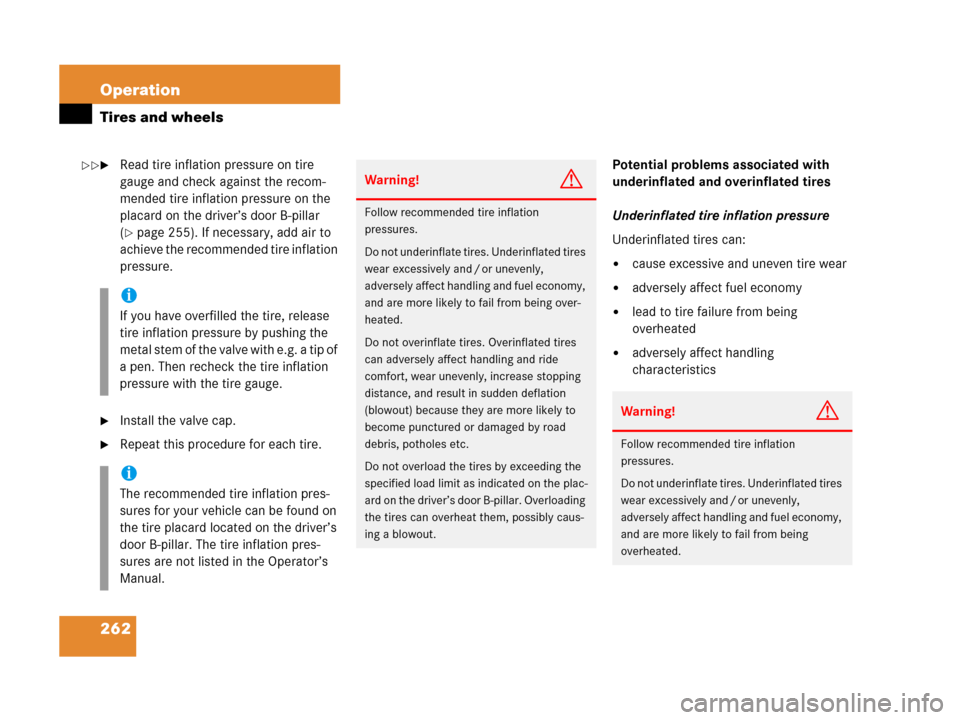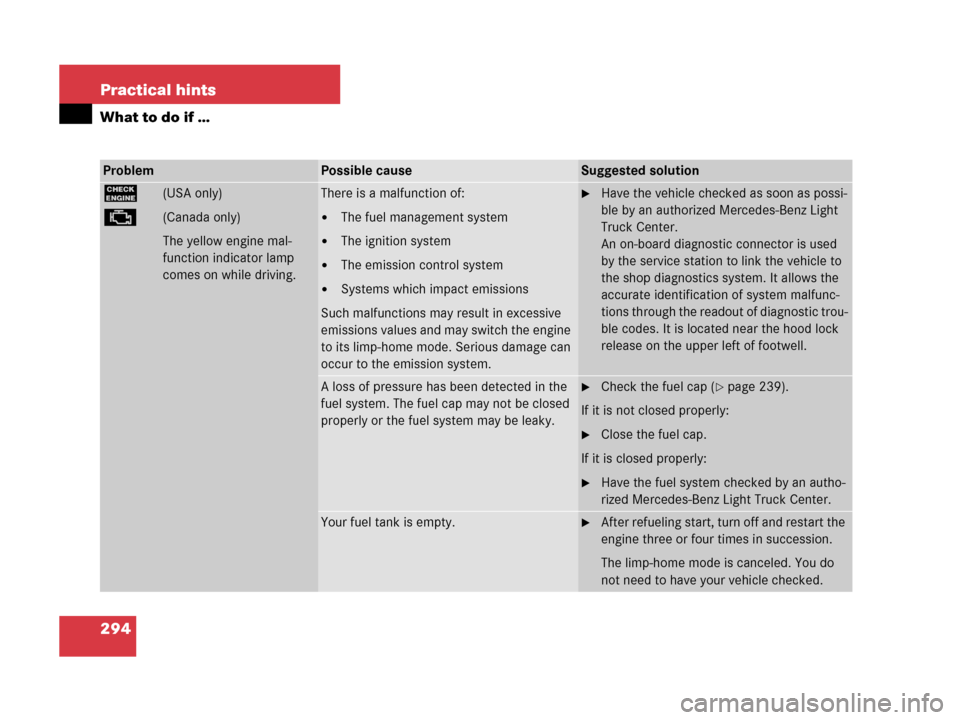Page 240 of 417

239 Operation
At the gas station
�At the gas station
Refueling
The fuel filler flap is located on the
right-hand side of the vehicle towards the
rear.
Locking/unlocking the vehicle with the re-
mote control automatically locks/unlocks
the fuel filler flap.1Fuel filler flap (including a placard on
the inner side with supplemental tire
inflation pressure information)
2Fuel cap
�Turn off the engine.
�Remove the SmartKey from the starter
switch.
�Open fuel filler flap1 by pushing at
the point indicated by the arrow.
�Turn fuel cap2 to the left and hold on
to it until possible pressure is released.
�Take off fuel cap2 and set it in the re-
cess on fuel filler flap1.
�To prevent fuel vapors from escaping
into open air, fully insert filler nozzle
unit.
�Only fill your tank until the filler nozzle
unit cuts out – do not top up or over-
fill.
�Replace fuel cap2 by turning it clock-
wise until it audibly engages.
�Close fuel filler flap1.
Warning!G
Gasoline is highly flammable and poisonous.
It burns violently and can cause serious inju-
ry. Whenever you are around gasoline, avoid
inhaling fumes and skin contact, extinguish
all smoking materials. Never allow sparks,
flame or smoking materials near gasoline!
Failure to remove the fuel cap slowly could
result in personal injury.
Warning!G
Overfilling of the fuel tank may create pres-
sure in the system which could cause a gas
discharge. This could cause the gas to spray
back out when removing the fuel pump noz-
zle, which could cause personal injury.
��
Page 263 of 417

262 Operation
Tires and wheels
�Read tire inflation pressure on tire
gauge and check against the recom-
mended tire inflation pressure on the
placard on the driver’s door B-pillar
(
�page 255). If necessary, add air to
achieve the recommended tire inflation
pressure.
�Install the valve cap.
�Repeat this procedure for each tire.Potential problems associated with
underinflated and overinflated tires
Underinflated tire inflation pressure
Underinflated tires can:
�cause excessive and uneven tire wear
�adversely affect fuel economy
�lead to tire failure from being
overheated
�adversely affect handling
characteristics
i
If you have overfilled the tire, release
tire inflation pressure by pushing the
metal stem of the valve with e.g. a tip of
a pen. Then recheck the tire inflation
pressure with the tire gauge.
i
The recommended tire inflation pres-
sures for your vehicle can be found on
the tire placard located on the driver’s
door B-pillar. The tire inflation pres-
sures are not listed in the Operator’s
Manual.
Warning!G
Follow recommended tire inflation
pressures.
Do not underinflate tires. Underinflated tires
wear excessively and / or unevenly,
adversely affect handling and fuel economy,
and are more likely to fail from being over-
heated.
Do not overinflate tires. Overinflated tires
can adversely affect handling and ride
comfort, wear unevenly, increase stopping
distance, and result in sudden deflation
(blowout) because they are more likely to
become punctured or damaged by road
debris, potholes etc.
Do not overload the tires by exceeding the
specified load limit as indicated on the plac-
ard on the driver’s door B-pillar. Overloading
the tires can overheat them, possibly caus-
ing a blowout.
Warning!G
Follow recommended tire inflation
pressures.
Do not underinflate tires. Underinflated tires
wear excessively and / or unevenly,
adversely affect handling and fuel economy,
and are more likely to fail from being
overheated.
��
Page 295 of 417

294 Practical hints
What to do if …
ProblemPossible causeSuggested solution
?(USA only)
± (Canada only)
The yellow engine mal-
function indicator lamp
comes on while driving.
There is a malfunction of:
�The fuel management system
�The ignition system
�The emission control system
�Systems which impact emissions
Such malfunctions may result in excessive
emissions values and may switch the engine
to its limp-home mode. Serious damage can
occur to the emission system.
�Have the vehicle checked as soon as possi-
ble by an authorized Mercedes-Benz Light
Truck Center.
An on-board diagnostic connector is used
by the service station to link the vehicle to
the shop diagnostics system. It allows the
accurate identification of system malfunc-
tions through the readout of diagnostic trou-
ble codes. It is located near the hood lock
release on the upper left of footwell.
A loss of pressure has been detected in the
fuel system. The fuel cap may not be closed
properly or the fuel system may be leaky.�Check the fuel cap (�page 239).
If it is not closed properly:
�Close the fuel cap.
If it is closed properly:
�Have the fuel system checked by an autho-
rized Mercedes-Benz Light Truck Center.
Your fuel tank is empty.�After refueling start, turn off and restart the
engine three or four times in succession.
The limp-home mode is canceled. You do
not need to have your vehicle checked.